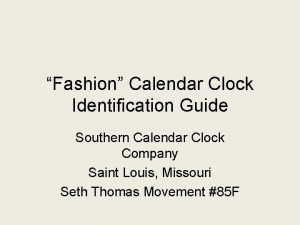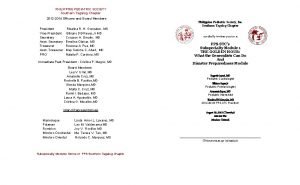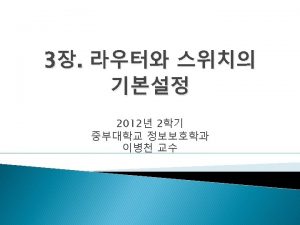Fashion Calendar Clock Identification Guide Southern Calendar Clock






















- Slides: 22

“Fashion” Calendar Clock Identification Guide Southern Calendar Clock Company Saint Louis, Missouri Seth Thomas Movement #85 F

Movement Specifications • No. 85 F – 8 Day, extra large, pendulum, strike, spring, with calendar attachments, old Fashion. Pendulum, from center of movement to end of rating screw, 9 13/16”, with No. 33 ball; diameter of ball 2 11/16”. Wood rod. Crown 60 dead-beat, center 1 5/8”. Length 7 7/8” width 7 ¼”, depth 3 5/8”. Time mainspring No. 136, 11 ½’ x ¾” x. 018”. Strike mainspring No. 136.

Tooth Count • Time Train Strike Train • Escape Wheel 60 Warning Wheel 40 • Third Wheel 90 • Second Wheel 84 • Main Wheel 96 Maintenance Cam 48 Second Wheel 84 Main Wheel 96

Movement (Assembled)

Movement (Rear View)

Motion Work The 3 5/8” depth dimension in the list of Seth Thomas movements, is taken from the backboard of the cabinet to the tip of the minute hand arbor. The movement is attached to the backboard by means of four screws; two brass and two steel. Before the plates can be separated, you must perform several advance operations. 1 st: Remove the roll pin extension from the seconds hand arbor. Use caution not to bend or break the tip. 2 nd: Wind the mainsprings on each train sufficiently tight to secure them with “C” rings and let off all power by holding back the clicks with a small screw driver. 3 rd: Remove the two (screws) and retaining brackets securing the winding ratchets. Remove the winding ratchets allowing the trains to fully unwind. 4 th: Detach the return spring on the hammer rod. 5 th: Remove the calendar cam and wire retainer that secure the drive wheel to the motion works.

Motion Work Disassembly (Cont’d) 6 th: Both the calendar cam and the calendar cam arbor are secured by wire retainers. In most cases, the fit between the cam and arbor is extremely tight. Use caution when prying the cam from the arbor. 7 th: Remove the calendar cam arbor from the motion works.

Disassembly Continued The calendar cam, arbor and washer.

Motion Work Disassembly (Cont’d) 8 th: Remove the retaining wire and washer that secure the canon wheel. Remove all components of the motion works.

Motion Work Disassembly (Cont’d) 9 th: Remove the canon wheel.

Motion Works Disassembly (Cont’d) 10 th: Remove the reduction gears by gently lifting them off of their arbors. You may have to use a thin blade to remove the cog from the minute hand arbor.

Motion Works Disassembly (Cont’d) 11 th: Using a fine needle nose pliers, grasp and pull the pin protruding from the minute hand arbor. You may need to drive the pin out if it can not be grasped with pliers. Place this pin in a plastic bag so that it is not lost during the cleaning process.

Disassembly Continued Remove the two screws, retainers and Geneva stops from front plate.

Disassembly Continued Remove the front plate while lifting up on the crutch wire. It is a good idea to disengage the hammer return spring during this process.

Disassembly – Plate Removal After removing the upper plate, make note of the relationship between the warning lever and the pin on the stop or warning wheel. The warning wheel pin should be approximately 180 degrees from the warning lever

Warning Wheel Orientation Correct placement of warning wheel pin and warning lever.

Front Plate

Count Wheel Orientation It is recommended that prior to removing the count wheel it is marked so as to identify the front and back. It is possible to install the wheel backwards. A single punch mark is sufficient. Likewise, it is important to identify the main wheel of each train to avoid interchanging them.

Calendar Arm Retainer Totally enclosed retainer

Strike Manual Override Guide A convenient steel eye is riveted to the back of the front plate serving to guide the manual override rod that is attached to the arm of the stop lever.

Fly Fan Pivot Hole There is a single pivot hole for the fly fan on the front plate of this movement, and it is directly above the warning wheel pivot hole.

Stop Lever Arm Upward motion of the manual override rod unlocks and advances the strike train one hour.
 Southern calendar clock company
Southern calendar clock company Central pocket vs plain whorl
Central pocket vs plain whorl Fast clock to slow clock synchronization
Fast clock to slow clock synchronization 60 seconds make 1 minute
60 seconds make 1 minute Cattle killing south africa
Cattle killing south africa Tokyo climograph
Tokyo climograph China hemisphere
China hemisphere Southern gothic to kill a mockingbird
Southern gothic to kill a mockingbird Name the southern colonies
Name the southern colonies Southern timber prices
Southern timber prices Rses southern region
Rses southern region Southern gothic style
Southern gothic style Brain wrinkles southern and eastern asia
Brain wrinkles southern and eastern asia Brain wrinkles southern and eastern asia
Brain wrinkles southern and eastern asia Southeast cfs
Southeast cfs Chapter 24 southern africa
Chapter 24 southern africa Long lot settlement pattern
Long lot settlement pattern Slash and burn agriculture
Slash and burn agriculture Pps southern tagalog chapter
Pps southern tagalog chapter Religion southern colonies
Religion southern colonies Southern view chapel
Southern view chapel Northern words vs southern words
Northern words vs southern words What is the hemisphere of japan
What is the hemisphere of japan











































